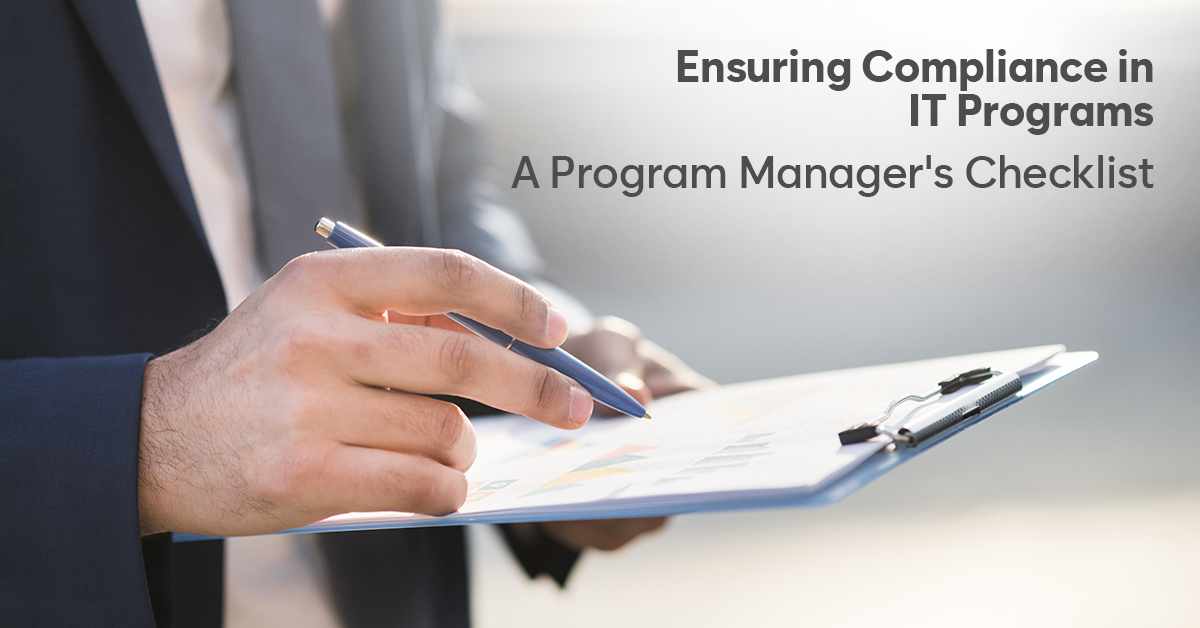In the ever-evolving landscape of information technology (IT), ensuring compliance is a paramount concern for program managers. With the increasing complexity of regulations and standards, maintaining adherence to these requirements is crucial not only for legal reasons but also for the overall success and reputation of IT programs.
In this blog post, we’ll explore a comprehensive checklist that program managers can follow to ensure compliance in their IT programs.
Establish a Robust Governance Framework
The foundation of compliance lies in a well-defined governance framework. Program managers must create and implement policies, procedures, and controls that align with relevant regulations and industry standards. This includes identifying key stakeholders, defining their roles and responsibilities, and establishing communication channels for effective collaboration. A clear governance structure provides the necessary oversight to ensure that compliance remains a priority throughout the program’s lifecycle.
Conduct Regular Risk Assessments
Risk assessments are essential for identifying potential compliance risks and vulnerabilities. Program managers should regularly assess the IT program’s processes, systems, and data to pinpoint areas that may be susceptible to non-compliance. This proactive approach allows for the implementation of mitigation strategies before issues arise, reducing the likelihood of regulatory violations and associated penalties.
Stay Informed About Regulatory Changes
The regulatory landscape is dynamic, with laws and standards constantly evolving. Program managers must stay informed about any changes to regulations that may impact their IT programs. Establishing a mechanism for monitoring and tracking regulatory updates ensures that the program remains aligned with the latest compliance requirements. Regular training and awareness sessions for the program team can also help disseminate information about regulatory changes and their implications.
Implement a Robust Documentation System
Accurate and comprehensive documentation is a cornerstone of compliance. Program managers should establish a systematic approach to document processes, policies, and controls within the IT program. This includes maintaining records of risk assessments, audit findings, and any corrective actions taken. A well-organized documentation system not only facilitates transparency but also serves as evidence of compliance during audits or assessments.
Conduct Regular Audits and Assessments
Regular audits and assessments are instrumental in validating the effectiveness of compliance measures. Program managers should schedule periodic internal audits to evaluate the program’s adherence to established policies and procedures. External audits by independent third parties can provide an unbiased evaluation and offer valuable insights into potential areas for improvement. The findings from these audits should be used to refine and enhance the compliance framework.
Also Read- Automated Software Testing for Continuous Delivery
Foster a Culture of Compliance
Ensuring compliance is not just a checkbox activity; it’s a cultural commitment. Program managers should foster a culture of compliance within the IT program by promoting awareness, accountability, and ethical behavior. This involves providing ongoing training to the team, emphasizing the importance of compliance in achieving organizational goals, and recognizing and rewarding individuals who contribute to maintaining a compliant environment.
Establish a Response Plan for Non-Compliance
Despite meticulous efforts, non-compliance incidents may occur. Program managers should have a well-defined response plan in place to address such situations promptly. This plan should outline the steps to be taken, responsibilities of key stakeholders, and communication strategies to manage the fallout effectively. Swift and transparent action in response to non-compliance helps mitigate potential damage to the program and its reputation.
Conclusion
In the complex world of IT programs, compliance is not an option; it’s a necessity. Program managers play a pivotal role in ensuring that their IT programs adhere to relevant regulations and standards.
By following this comprehensive checklist—establishing a robust governance framework, conducting regular risk assessments, staying informed about regulatory changes, implementing a robust documentation system, conducting regular audits and assessments, fostering a culture of compliance, and establishing a response plan for non-compliance—program managers can significantly enhance their programs’ ability to meet compliance requirements and thrive in the ever-changing IT landscape.






